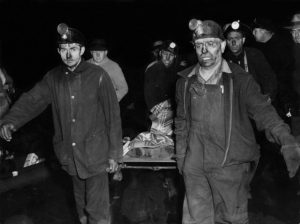 Lots more today as Workers Memorial Day approaches:
Lots more today as Workers Memorial Day approaches:
First, ME. The Economic Policy Institute has published a Workers Memorial Day blog post by ME explaining how the attacks on worker protection are not limited to OSHA, but White House, EPA, USDA, Congress and others have joined in to the effort to undermine worker safety and health and the science that forms the basis of worker and environmental protections. And I remind you again that
Action by unions, lawsuits, and media oversight have slowed, but not stopped, the assault on workers by the Republican Congress and the Trump administration. The best way to stop them is to take back the House of Representatives—or even the Senate—in November.
Meanwhile workers and activists need to ensure that politicians, journalists, and government agencies are aware of what working people go through every day and the struggle takes to simply come home alive and healthy from work in this country. Only by educating, standing up, and fighting back will this scourge end.
Kathy Rest, executive director of the Union of Concerned Scientists, writing in Scientific American, provides a comprehensive review of the attacks on the progress that his been made in workplace safety and the efforts to roll back those gains by the Trump administration and Congress. Rest reminds us that:
Virtually all work-related injuries and illnesses are preventable. There’s no shortage of proven technologies, strategies and approaches to preventing them. From redesign, substitution and engineering solutions that eliminate or otherwise control hazards and exposures to safety management systems, worker training programs, protective equipment, and medical screening and surveillance programs, there are multiple paths to prevention. And, as a former assistant secretary of labor for occupational safety and health, David Michaels, recently wrote in Harvard Business Review, safety management and operational excellence are intimately linked.
And Katie Johnson, writing in the Boston Globe, describes the “growing legion of independent contractors and temp workers with few if any employment protections.” Johnson cites MASSCOSH’s annual “Dying For Work” report.
“Young people in particular are at risk because there are so many of them working as contractors in the burgeoning gig economy, said Jodi Sugerman-Brozan, executive director of MassCOSH. “You’re injured or hurt on the job, it’s your problem,” she said. “It’s part of the changing nature of work. The workers are just seeing the raw end of every deal.”
“You’re injured or hurt on the job, it’s your problem,” she said. “It’s part of the changing nature of work. The workers are just seeing the raw end of every deal.”
What’s going on?
David Weil, former head of the Department of Labor’s Wage and Hour Division under President Obama and now dean of the Heller School for Social Policy and Management at Brandeis University, said the growth of the gig economy is problematic because digital platforms like DoorDash and Uber don’t consider themselves to be employers of the workers carrying out their services, and therefore aren’t looking out for them.
“Who’s responsible for the health and safety of this network of people now running around in their cars doing delivery work?” he said. “If the platform isn’t responsible, they’re not going to think about: How do I create a system of safety?”